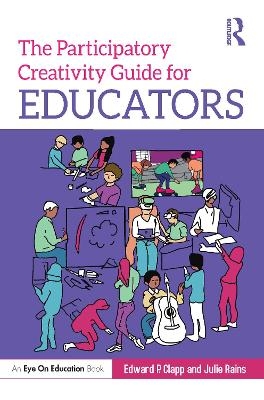
The Participatory Creativity Guide for Educators
Routledge (Verlag)
978-0-367-67827-2 (ISBN)
Bringing the principles of participatory creativity into the classroom, this book helps educators reframe invention and innovation, democratize the creative process, and leverage the knowledge, skills, background experiences, and cultural perspectives that students bring with them every day. Key concepts are illustrated through rich vignettes and pictures of practice as chapters walk you through the what, why, and how of incorporating participatory creativity into your teaching and learning environment.
Designed for educators in a vast array of settings (including schools, community centers, museums, afterschool programs, and grandpa’s backyard workshop), this book is key reading for any educator looking to use creativity to strengthen and expand their teaching and learning.
Edward P. Clapp is a principal investigator at Project Zero and a lecturer on education at the Harvard Graduate School of Education in Cambridge, Massachusetts. Julie Rains is a longtime educator and the current instructional innovation program consultant for Rochester Community Schools in Rochester, Michigan. Julie facilitates a variety of in-person and online professional learning experiences through her work with Project Zero at the Harvard Graduate School of Education.
List of Tables and Figures
Meet the Authors
Acknowledgements
Chapter 1: Introduction
What is Participatory Creativity?
The What, Why, and, How of Participatory Creativity
Participatory Creativity in Practice
Meet the Authors
A Bit about Process and Context
Who Should Read this Book?
How to Use this Book
A Road Map to the Journey Ahead
Chapter 2: Participatory Creativity 101
The Problem with Traditional, Individual-based Understandings of Creativity
Moving Towards a Sociocultural Understanding of Creativity
What Makes Participatory Creativity Different from Other Brands of Sociocultural Creativity Theory
So, What Makes Participatory Creativity Creative?
Why Reframe Creativity as a Distributed and Participatory Process?
The Five Crises of Creativity Stemming from a Culture of Individualism
The Three Crises of Creativity Associated with a Culture of Power
The Four Key Concepts of Participatory Creativity
Popular Pitfalls and Misconceptions
Chapter 3: Establishing a Participatory Creativity Classroom
What Does a Participatory Creativity Classroom Look Like?
Any Classroom Can Be a Participatory Creativity Classroom
Flexibility Is Key
The 12 Practices of Participatory Creativity
According to Whom?, For Whom?, and Who am I?
Chapter 4: Participatory Creativity in Action
Finding Future Potential in Past Histories
Fostering Creative Identity Development
Participatory Creativity in the Culturally Responsive Classroom
Identifying Roles for Oneself and Others
How Did We Participate Today?
Socially Constructing the Origins of Us
The Strange Ducks Club—Teaching and Learning (and Other Weird Things that Happen) in a Sandbox
Amplifying All Voices in the Creative Classroom
A Participatory Approach to Assessment
Empowering Representation: Girls of the Crescent
What’s Your Story?
Chapter 5: The Participatory Creativity Toolkit
Socially Distributed Idea Development
Biography of an Idea
Concept of Role
Profiles of Participation
Using Pedagogical Tools in Your Context
Chapter 6: Conclusion
The Future Potentials of the Creative Classroom
The Next Frontiers for Participatory Creativity
References and Suggestions for Further Reading
| Erscheinungsdatum | 05.03.2024 |
|---|---|
| Zusatzinfo | 1 Tables, black and white; 6 Line drawings, black and white; 27 Halftones, black and white; 33 Illustrations, black and white |
| Verlagsort | London |
| Sprache | englisch |
| Maße | 152 x 229 mm |
| Gewicht | 430 g |
| Themenwelt | Schulbuch / Wörterbuch |
| Sozialwissenschaften ► Pädagogik | |
| ISBN-10 | 0-367-67827-6 / 0367678276 |
| ISBN-13 | 978-0-367-67827-2 / 9780367678272 |
| Zustand | Neuware |
| Haben Sie eine Frage zum Produkt? |
aus dem Bereich


